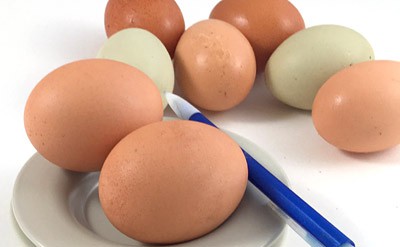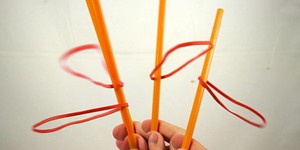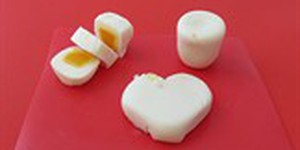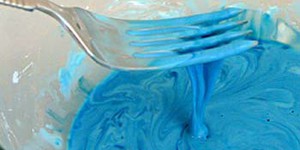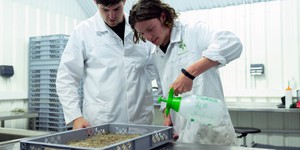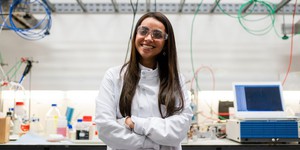Is the Egg Raw or Cooked? That is the Question!
Summary
Introduction
Have you ever found an egg in your refrigerator and wondered if it was cooked? Although eggs drastically change inside their shells when cooked, it is still remarkably difficult to distinguish a cooked egg from a raw one without cracking it open. In this activity, you will find out how physics can help you tell the difference!
Materials
- At least six chicken eggs, similar in size and color
- Saucepan
- Stove (Use caution and ask an adult to help you use the stove and handle hot items in this activity.)
- Water
- Timer
- Slotted spoon
- Pencil
- Two small plates
- Sheet of paper
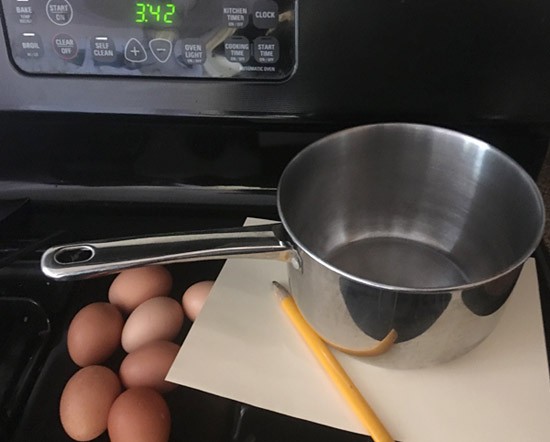 Image Credit: Sabine De Brabandere, Science Buddies / Science Buddies
Image Credit: Sabine De Brabandere, Science Buddies / Science Buddies
Prep Work
- Place three eggs in the saucepan. Add enough water so there is half an inch covering the eggs. Put the saucepan on the stove.
- Heat the water until it comes to a rapid boil and keep it boiling for seven minutes.How do you think the eggs are changing during this time?
- Turn off the heat.
- Use the slotted spoon to take one egg at a time out of the hot water, rinse it under running cold water (optional), and store it in a safe place where it can cool completely.
- Use a pencil to make a small mark on the three raw eggs. Keep the mark subtle, as this will make it easier to test your ideas in an unbiased way.
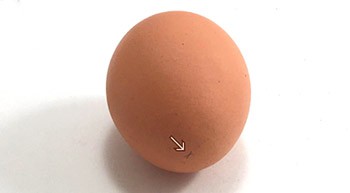 Image Credit: Sabine De Brabandere, Science Buddies / Science Buddies
Image Credit: Sabine De Brabandere, Science Buddies / Science Buddies
- Store the raw eggs together with the cooked ones. This ensures that all the eggs are at the same temperature when you start experimenting.
Instructions
- Choose a raw egg and crack it open on a plate.How does the content of the raw egg look?
- Repeat the first step with a cooked egg.How does the content of the cooked egg differ from that of the raw egg?
 Image Credit: Sabine De Brabandere, Science Buddies / Science Buddies
Image Credit: Sabine De Brabandere, Science Buddies / Science Buddies
- The goal of this activity is to create a test to identify whether an egg is cooked or raw without cracking the shell.What are your ideas?
- Choose one cooked and one raw egg from the four uncracked eggs that are left. Remember there is a mark on the raw egg. Put the other pair of eggs aside for now.
- If you observe any differences, note them on your sheet of paper. This will help you identify which type shows a particular characteristic.
- Look at the eggs, smell them, and weigh them in your hands.Does one look different, smell different, or seem heavier than the other?
- Gently tap your pencil against the cooked and raw egg and listen.Can you hear a difference?
- Shake the eggs one at a time close to your ear.Can you hear which one is raw?
- Put one egg on its tip and gently spin it. Lay it flat and spin it. Try it a few times before switching to the other egg.Does one spin more easily than the other?
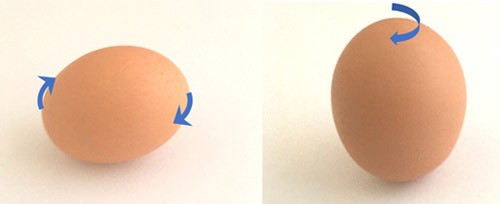 Image Credit: Sabine De Brabandere, Science Buddies / Science Buddies
Image Credit: Sabine De Brabandere, Science Buddies / Science Buddies
- Perform any other tests and look for any other distinguishing characteristics you can think of.
- Review your notes.Did you find differences? If so, do you think those differences are there because one of the eggs is cooked and the other is not? Why or why not?
- If you found any differences between the raw and cooked egg, test if those differences also exist in your last pair of eggs.Does this difference distinguish the raw from the cooked egg in this pair, too? If you found a difference that held up for both pairs, do you think it can differentiate all cooked eggs from raw eggs? Why do you think the differences occur?
What Happened?
Did you notice that the inside of a raw egg is liquid, while the inside of a cooked egg is solid? It was probably impossible to tell the difference without cracking the shell until you tried to spin the egg. Even though it is difficult to spin a cooked egg, spinning a raw egg was probably much harder. This is expected.
When you boil an egg, the inside becomes solid. It does not change how the egg looks or its odor, so you cannot see or smell the difference. Shaking a raw egg does not make a sloshing sound because the liquid in the egg is contained in a membrane and only a small air bubble is present. Neither egg is hollow, so tapping it does not produce a clear audible difference.
You can tell the difference between a cooked and a raw egg by spinning it: a cooked egg is easier to spin. Because the inside of a cooked egg is solid, the particles inside cannot move around relative to each other or the shell. The whole egg moves in unison. When you spin the cooked egg by twisting its shell, the whole inside moves along with the shell. In a raw egg, the inside is still liquid. The particles that make up the liquid can slide and move around relative to each other and the shell. When you spin the shell of the raw egg, the liquid inside does not start spinning right away—it needs some time to "catch up"—and friction between the shell and the liquid slows down the spinning motion. Since it is easier to balance an egg on its tip by spinning it faster, this also makes cooked eggs easier to balance than raw eggs. It also helps that the inside of the cooked egg is less wobbly since it does not move around (its center of mass is fixed).
Digging Deeper
In essence, a bird egg contains a yolk enclosed in a membrane and surrounded by a white liquid (the albumen or egg white), all packaged together in a hard shell. The albumen mainly consists of proteins floating around in water. In addition to water, the yolk holds protein, some fat, and the majority of the vitamin and mineral content of the egg.
Before exposure to heat, the albumen and yolk are both liquids; their particles are not stuck to the particles close to them, but flow alongside and over one another. The yolk is separated from the albumen by a membrane, but the particles inside are free to move around.
When heated, the inside of the egg undergoes a chemical change. The egg proteins unravel and bond, resulting in a network of proteins that traps water. As a result, the egg yolk and white become a gel-like, flexible solid. When the egg cools, the bonds become more rigid and its contents become solid; it has a fixed shape and mass distribution.
The shell of an egg is mainly made off calcium carbonate. It does not change when placed in boiling water. Although the shell has pores that allow moisture, air, and other small particles to pass through, almost no exchange of matter occurs during the cooking process. This implies that the mass of the egg does not significantly change.
If you boil an egg in its shell, its appearance does not change, and neither does its mass. You can tell the difference between the cooked and a raw egg by spinning it on its point. The solid inside of a cooked egg rotates in unison with its shell, making it relatively easy to balance a spinning cooked egg on its tip. The liquid inside of a raw egg slides against itself and the shell. This slows the rotation down and makes it almost impossible to balance a spinning cooked egg on its tip.
Ask an Expert
For Further Exploration
- A cooked egg spins more easily than the raw egg because its inside is solid. Rotating a cup with water and an ice cube demonstrates the difference between a rotating liquid and a rotating solid. Fill a cup halfway with water and set it on a saucer. Put one drop of food coloring into the water near the edge of the cup and start rotating the cup. Watch what happens. Take an ice cube, stick if firmly into another cup and set the cup on a saucer. Add a single drop of food coloring on the ice and start rotating the cup. Do you think the drop will rotate with the cup? Will the drop of color spread out when it is in the liquid or in the ice? What does that tell you about how the particles inside a liquid or solid move when their container rotates? Could this information help you explain why a cooked egg spins differently compared to a raw one?
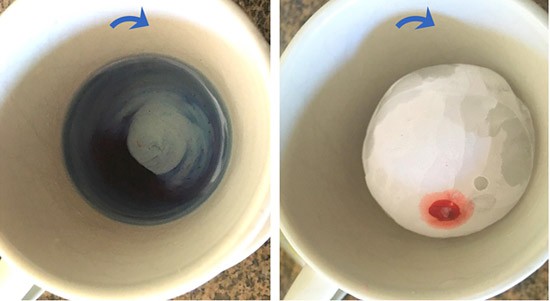 Image Credit: Sabine De Brabandere, Science Buddies / Science Buddies
Image Credit: Sabine De Brabandere, Science Buddies / Science Buddies


